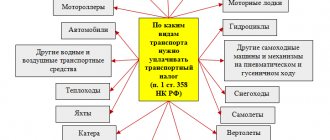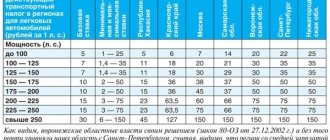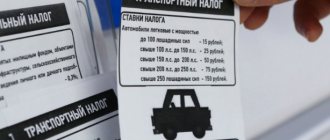Transport tax - what is it?
Transport tax is a regional tax
, which is regulated by Chapter 28 of the Tax Code of the Russian Federation. The Tax Code of the Russian Federation spells out the basic rules governing the object of taxation, tax payers, calculation and payment rules.
That is, the basic conditions are prescribed at the federal level, but regional authorities have the right to make their own adjustments. Important: regional authorities cannot worsen the rights of taxpayers. In addition, regions set tax rates and preferential categories of payers.
Who is the tax payer?
Both citizens and legal entities are required to pay transport tax
. But in our article we will talk specifically about individuals. The person in whose name the corresponding vehicle is registered must pay the transport tax.
It is worth noting that a minor child can also be a transport tax payer. For example, if a child received a car as a gift from a relative (and legislation in Russia does not prohibit this). In this case, the transport tax must be paid by the parent of the minor child.
.
How to become a taxpayer
Individuals and legal entities become taxpayers if:
- An object that arose as a “transaction” is fully taxed, that is, the payer will have to pay for it. An example is real estate and income generated from sales or services provided through this real estate.
- There is a status according to which a taxable object is formed. An example is imputed income. It is formed when the organization issues UTII.
- Uses any resources. For example, extracts minerals, or something else.
Direct tax is paid by both individuals and legal entities. They must deposit the amount themselves, without shifting their responsibilities to another person.
What is the object of taxation
Object
taxation are:
- cars;
- motorcycles;
- self-propelled machines and vehicles on pneumatic and caterpillar tracks;
- snowmobiles and motor sleighs;
- air transport (planes and helicopters);
- marine vehicles (motor ships, boats, yachts and jet skis).
But there are exceptions
, which include:
- passenger cars with engine power up to 100 horsepower (purchased through the social security department);
- cars equipped for disabled people;
- tractors, self-propelled combines and special vehicles for transporting milk, poultry, which are used for agriculture (for individual entrepreneurs);
- fishing vessels (for individual entrepreneurs).
Tax is not calculated for these vehicles
.
General provisions
Transport tax did not always exist. It came into effect in 2013. The state spends huge sums on road repairs and environmental protection, so these wastes are to some extent assigned to vehicle owners.
The owner of the car compensates for the damage caused to the environment through:
- Transport tax.
- Excise tax on gasoline.
- Excise tax on automobile production.
- Tolls.
All funds go to the budgets of the country's constituent entities. Chapter 28 of the Tax Code of the Russian Federation prescribes the procedure, amount and deadline for paying taxes. For the largest taxpayers there is a separate procedure regulated by Article 363.1 of the Tax Code).
Taxpayers
Every person who owns real estate, in particular a vehicle, is a taxpayer.
If you are an individual, you must pay a certain amount that the tax office will charge you. To make a calculation, you need to know information about the vehicle. They, in turn, are provided by the authorities that carry out state registration of transport.
If the payer is a legal entity, then it must independently transfer the amount of the advance payment and tax.
Unless otherwise specified, the tax amount is calculated by multiplying the tax base and the tax rate. The result is summarized every tax period.
The amount for a legal entity is calculated slightly differently. An advance payment is made throughout the tax period. Next, the advance payment is deducted from the amount received.
Law firms pay cash at the end of each reporting period. The final figure is calculated as ¼ of the tax base multiplied by the tax rate.
Object of taxation
You will need to pay tax if you own the following vehicles:
- passenger cars;
- buses;
- tractors;
- air transport: airplanes and helicopters;
- water transport: yachts, boats, sailing ships, jet skis, motor boats, etc.;
- tracked transport;
- motorcycles;
- snowmobiles;
- non-propelled vessels.
According to Article 358 of the Tax Code of the Russian Federation, it is allowed not to pay tax on such objects as:
- Boats with power up to 5 horsepower or with oars.
- Fishing and river ships.
- Specialized vehicles for driving by disabled people (with an engine up to 100 horsepower).
- Vessels for transporting passengers and cargo vessels (river, sea, air) belonging to state property.
- Tractors and combines.
- Ships registered in the international registry.
- Air transport used for medical purposes.
- State transport registered in the region where military service is carried out.
The tax base depends on:
- what is the power of the vehicle;
- what is the statistical thrust of air transport;
- what is the gross tonnage of water transport.
What affects the amount of tax?
The tax rate is determined by law in each individual subject of the Russian Federation. It depends on:
- Engine horsepower.
- The volume of the vessel's enclosed spaces.
- Transport categories.
- The age of the vehicle and the duration of its operation.
If the cost of the car is more than 3 million rubles, then an increasing factor is used.
The following types of coefficients are distinguished:
- k 1, if the cost of the car is 3–5 million and the age is 2–3 years;
- k3, if the cost of the car is 3–5 million and the age is 1–2 years;
- k5, if the cost of the car is 3–5 million and the age is up to 1 year;
- k 2, if the cost of the car is 5–10 million and the age is up to 5 years;
- k 3, if the cost of the car is 10–15 million, and the age of the car is up to 10 years;
- k 3, if the cost of the car is from 15 million, and the age of the car is up to 20 years.
If the tax office has issued an incorrect amount, you can challenge it:
- The cost is paid according to the receipt.
- An objection form is filled out.
- Documents about benefits or that the car has been deregistered and others are provided.
If a person has moved to another city, then he needs to apply and register with the MREO at his place of residence. There is no need to contact the tax service yourself; the data will be transferred automatically.
If the fact of removal and re-registration was carried out in one day, you will still have to pay for a full month of operation.
Transport tax rates
Transport tax rates are set by regional authorities
. However, Article 361 of the Tax Code of the Russian Federation indicates approximate values of transport tax, which regions have the right to reduce or increase by no more than 10 times, with the exception of cars with an engine power of up to 150 hp.
The main criterion for determining the tax rate is engine power. In addition, regional authorities have the right to set additional tax rates depending on the environmental class of the vehicle and the number of years of use.
For example, let’s take transport tax rates in Moscow
, approved by the Moscow Law of July 9, 2008 No. 33 “On Transport Tax”:
- engine power up to 100 hp (up to 73.55 kW) inclusive – 12 rubles/hp;
- over 100 hp up to 125 hp (over 73.55 kW to 91.94 kW) inclusive – 25 rub./hp;
- over 125 hp up to 150 hp (over 91.94 kW to 110.33 kW) inclusive – 35 rub./hp;
- over 150 hp up to 175 hp (over 110.33 kW to 128.7 kW) inclusive – 45 rub./hp;
- over 175 hp up to 200 hp (over 128.7 kW to 147.1 kW) inclusive – 50 rub./hp;
- over 200 hp up to 225 hp (over 147.1 kW to 165.5 kW) inclusive – 65 rub./hp;
- over 225 hp up to 250 hp (over 165.5 kW to 183.9 kW) inclusive – 75 rub./hp;
- over 250 hp (over 183.9 kW) – 150 rub./hp.
, an increasing factor is applied to expensive cars
- 1.1 – for cars worth from 3 to 5 million rubles inclusive, no more than three years have passed since the year of manufacture;
- 2 – for cars worth from 5 to 10 million rubles inclusive, no more than five years have passed since the year of manufacture;
- 3 - for cars costing from 10 to 15 million rubles inclusive, no more than 10 years have passed since the year of manufacture, and costing from 15 million rubles, no more than 20 years have passed since the year of manufacture.
Every year the Ministry of Industry and Trade determines a list of cars whose cost exceeds 3 million rubles
, and publishes it on its official website before March 1 of each year.
The list of expensive cars in 2021 can be found here.
Tax base for transport tax
The tax base for transport tax in 2021 is calculated differently for certain types of vehicles (Article 359 of the Tax Code of the Russian Federation).
| Type of vehicle (VV) | Tax base for calculating transport tax | Source of information about the tax base | Comments |
| Vehicles with engines | Engine power (Nd) in horsepower (hp) | Indicator for calculation:
| If Nd or Nds is indicated in kW, it is necessary to convert this indicator to l. With. according to the formula: Nd (hp) = Nd (kW) × K, where K = 1.35962 – conversion factor from kW to hp. With. The result of calculations is rounded up to 2 decimal places |
| Water vehicles | Power of the vessel's engines registered as a water vehicle (Nds) | ||
| Waterborne, non-self-propelled (towed) vehicles, for which gross tonnage is determined | Gross tonnage in register tons (gt) | Vessel's measurement certificate issued by technical supervision authorities | The indicator is established by measuring the internal volume of the vessel 1 rub. t = 100 cubic meters ft = 2.83 m3 |
| Air vehicles for which jet engine thrust is determined | Static thrust of a jet engine (total nameplate static thrust of all jet engines) of an air vehicle during takeoff in terrestrial conditions in kilograms of force (kgf) | Air vehicle passport | In Art. 361 of the Tax Code of the Russian Federation for aircraft with jet engines, the tax rate is 20 rubles. for each kgf - conversion to l. With. not required to determine tax |
| Other water and air vehicles that do not have engines or for which the gross tonnage is not determined | ETS (vehicle unit) | — | Such vehicles include:
|
Tax benefits
Transport tax benefits are established by regional regulations. In most cases, the following are exempt from paying transport tax:
- disabled people of groups I and II;
- WWII veterans;
- Heroes of the Soviet Union, Heroes of the Russian Federation, Russians awarded the Order of Glory of three degrees;
- combat veterans;
- one of the parents of a disabled child.
Some regions provide benefits
and other categories of people:
- one of the parents of a large family;
- Chernobyl victims;
- people who participated in the liquidation of nuclear accidents or in testing nuclear weapons.
However, each region has its own preferential categories of taxpayers
. More detailed information about all the benefits provided can be found at the local Federal Tax Service inspectorate.
It is worth noting that benefits for the above categories of people are provided only for 1 car, which is chosen by the payer himself. To provide a benefit, you must write to the Federal Tax Service an application about the selected preferential object of taxation and attach a document confirming the benefit.
If the beneficiary belongs to several categories
payers who are exempt from transport tax, he has the right to take advantage of only one benefit in relation to one vehicle.
Some regions establish criteria not only for the tax payer, but also for the vehicle
. For example, in Moscow, a transport tax benefit can only be issued for a car with an engine power of no more than 200 horsepower. The only exception is a car that belongs to one of the parents of a large family (but there are no restrictions on the power of the car).
The Moscow authorities also exempted owners of electric vehicles from paying transport tax.
How is the transport tax calculated?
The vehicle owner does not have to calculate the amount of transport tax on his own
, this is the responsibility of the tax service. It is the Federal Tax Service, based on data received from the traffic police, that calculates the amount of tax and sends a notification about the amount of transport tax and the timing of its payment to the address of the owner of the vehicle.
The tax notice must be sent no later than 30 days before the tax payment deadline, that is, November 1. However, most often, tax notices are sent to payers' addresses in August-September.
The tax amount is paid in full rubles
. If, when calculating the transport tax, the amount turned out to be in kopecks, then 50 kopecks or more is rounded up to 1 ruble, and less than 50 kopecks is not taken into account at all.
It is worth noting that in the notification for payment of transport tax, calculations can be made for a period not exceeding three years
.
The payer has the right to check the correctness of the calculation independently. If the Federal Tax Service specialists made an error in the calculation - for example, they did not take into account the benefit or calculated the tax at a different rate, then the payer needs to contact the Federal Tax Service with an application for recalculation and documents confirming the error.
After fixing the error
, Federal Tax Service specialists will send a new tax notice to the owner of the vehicle indicating the corrected amount.
Check for correctness
Transport tax can be calculated using an online calculator located on the Federal Tax Service website. Before making the calculation, you should select the region in which the vehicle was registered in the lower right corner.
The calculation of the amount of tax paid is presented in sufficient detail in your personal account on the website of the Federal Tax Service:
By selecting your car, you can see the tax calculation parameters in detail:
Transport tax 2021: will it be canceled or not?
Since mid-summer, a lot of information has been periodically published on the Internet that the transport tax will be abolished in 2021. And car owners, reading such articles, mislead themselves.
In fact, State Duma deputy A.V. Baryshev introduced a bill for consideration
No. 1010832, according to which it was proposed to abolish the transport tax, that is, to exclude Chapter 28 from the Tax Code.
But on September 14, 2021, the bill was moved to the archive due to the lack of a conclusion from the Government of the Russian Federation. That is, the draft law was rejected without even passing the first reading. As a result, the transport tax will not be abolished in 2021
.
Payers of transport tax and the basic principles of its calculation
This tax is regional.
It must be paid by individuals and enterprises that own registered vehicles (Article 357 of the Tax Code of the Russian Federation). Individuals, individual entrepreneurs and LLCs pay the tax amount based on a notification from the Federal Tax Service, which is generated based on information provided by the authorities registering vehicles.
In some cases, you do not need to pay transport tax. And it's not just tax benefits. A complete list of such cases was provided by ConsultantPlus experts. Get trial access to the system for free and go to the Ready-made solution.
Enterprises calculate taxes and advances themselves. Moreover, until 2020 (that is, for the tax for 2021 inclusive), they were required to report on it to the Federal Tax Service. As of reporting for 2021, the filing of transport tax returns for organizations has been cancelled, and the Federal Tax Service must send them messages with the amount already calculated (similar to how it now does it for individual entrepreneurs and individuals). But legal entities will still calculate their taxes independently. First, they must know the amount in order to make advance payments throughout the year (if they are established in the region). And secondly, the message from the tax office is more of an informational nature, so that the company can compare its accruals with those made according to the tax authorities. After all, she will receive it after the deadline for paying advances (see, for example, letter of the Ministry of Finance dated June 19, 2019 No. 03-05-05-02/44672).
Test yourself! Recommendation from ConsultantPlus: Compare the amount of tax calculated by the inspectorate with the amount you calculated and paid yourself. If they are equal, then the tax was calculated and paid correctly. If the amounts differ, check...(see K+ for details).
Therefore, it is also important for companies in 2021 to know the basic principles of tax calculation. And they are as follows:
- the tax is calculated as the product of the tax base and the rate (unless otherwise reflected in the Tax Code of the Russian Federation);
- advances payable for tax are determined for each reporting period as ¼ of the tax base multiplied by the tax rate (Article 362 of the Tax Code of the Russian Federation);
- enterprises calculate tax payable as the difference between the amount accrued for the year and advance payments that were paid during the year; advance tax payments are not provided for individuals;
- the final amount of tax and the amount of advances on expensive cars is determined taking into account the increasing coefficient (from 1.1 to 3), established depending on the cost of the car and the number of years that have passed since its release (clause 2 of Article 362 of the Tax Code of the Russian Federation).









